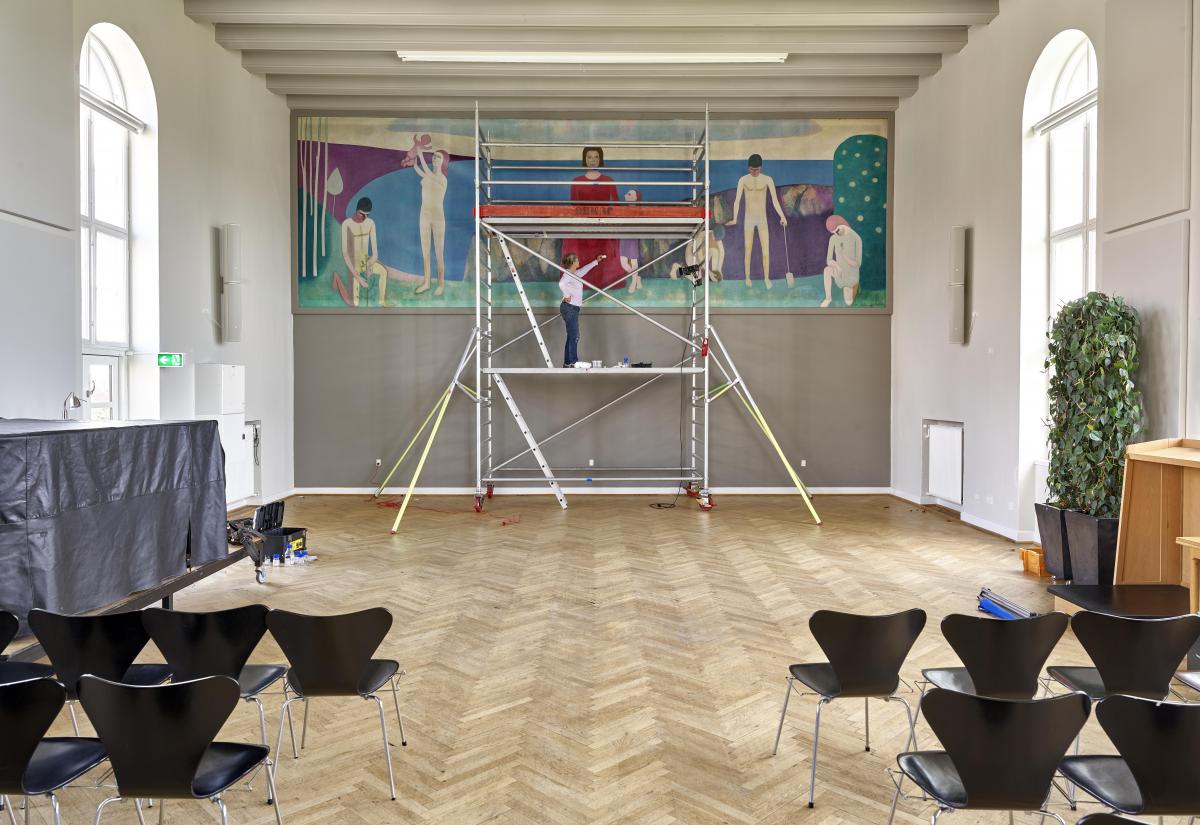When the conservators from the National Museum of Denmark inspected Niels Lergaard’s big painting at University College South Denmark, Haderslev Campus (the former Haderslev Statsseminarium), they found smudged paint and a loose canvas marred by holes, tears and bumps. Furthermore, the original oak frame, an integral part of the piece and designed by Lergaard himself, had been painted over the course of the years. The scale of the painting, which measures 3 x 9 metres, made it necessary to carry out the restoration on site. The work included flattening out bumps, patching holes and gluing tears, removing superficial dirt and retouching areas that had lost colour. During the process, the conservators also carried out analyses to learn more about Lergaard’s materials and techniques.
After months of comprehensive restoration work, the painting is now back up the wall in the assembly hall of the college in its original bright colours and original oak frame, just as Lergaard envisaged it.
Far from dark
Lergaard did not follow the prevailing artistic trends of his time. He was often described as a ‘Dark Painter’ in reference to the sombre colour palette that characterized the work of some Danish artists during the interwar years.
In 1953, Lergaard received a commissionn for a decorative project at the then Haderslev Statsseminarium, funded by the New Carlsberg Foundation. Familien, Oplysning, Forskning, Poesien was officially unveiled in December 1955, and it is far from dark. The painting is divided into wide vertical sections in bright shades of colour. The colour swaths define the depth composition of the painting, from the green grassy foreground to the saturated blue sea and further to the luminous horizon. Lergaard drew much of his inspiration from nature, and the sea view from the Danish island of Bornholm in the Baltic was one of his principal subjects.
Youth and education
The painting’s foreground shows human figures placed side by side. They give the piece a frieze-like character and tell the story of the opportunities of youth in light of the time following the two world wars: a tree being planted, an infant, working hands to build the world. Thus, the painting refers directly to the building’s former and current function as an institution of education where students come to learn.
About Niels Lergaard
Niels Lergaard (1893–1982) trained at Royal Danish Academy in Copenhagen from 1917 to 1920. In 1928, he and his family moved to Bornholm, where he worked and developed his range of subjects. Lergaard was inspired by the island’s dramatic landscape and was often described as a ‘Dark Painter’ due to the sombre colour palette that characterized his early work. Lergaard created decorative projects for the upper secondary schools Esbjerg Statsskole and Frederiksborg Statsskole and for Dansk Centralbibliotek for Sydslesvig (Danish Central Library for South Schleswig) and received the Eckersberg Medal in 1937 and the Thorvaldsen Medal in 1965. He is represented in many Danish museums, including SMK – National Gallery of Denmark.




